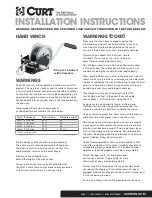
28
©
2019
Columbus McKinnon Industrial Products GmbH
Inspection before starting work
Before starting work inspect the hoist/trolley, chains and all load bearing components every time for visual defects. Furthermore test the
brake and make sure that the load and hoist/trolley are correctly attached by carrying out a short work cycle of lifting and lowering resp.
travelling in both directions. Selection and calculation of the proper suspension point and beam construction are the responsibility of the
operating company.
Daily checks by the regulator
• Check the proper fastening of the Yale continuous winch to the suspension.
• Check the working of the UP and DOWN as well as the EMERGENCY STOP button.
• Check the working of the limit switch: If the switch is pressed manually during the upward movement the load shall stop immediately.
Weekly checks
As damaged ropes endanger work safety, wire rope(s) must be checked for damage once per week (in accordance with Chapter
"Checking, Repair and Maintenance"). Replace, if necessary. This applies to the suspension rope as well as to the optionally used
safety rope.
To increase the life of wire ropes, ensure cleanliness and mild lubrication. Power supply and control cables must be checked regularly
and replaced if necessary.
Increasing the load capacity by suitable pulley blocks.
If the single max. nominal load capacity in direct pull is not sufficient, it can be multiplied by the use of return pulleys/wire rope blocks
based on the pulley block principle. The load is then distributed to several rope falls. The following requirements must be fulfilled:
• A competent person must establish that the load capacity of the return pulley is adequate.
• The return pulley must be provided with a device which prevents unintended opening.
• The return pulley must be rated for the same temperature range as the hoist.
• Only use hooks with a safety latch.
• The diameter of the return pulley must be at least 12 times the nominal rope diameter.
• The groove depth of the return pulley must be at least 1.5 times the nominal rope diameter.
• The return pulley must be provided with a rope guide ensuring that the rope remains in the groove of the return pulley also in the event
of slack rope.
Lifting/lowering the load
The load is lifted by depressing the
Ÿ
-button, it is lowered by depressing the
ź
-button. For hoists with two speeds: The first stage of
button depression activates the slow speed, further depression activates the faster speed. The slow speed may only be used for short
distances.
Stop and EMERGENCY STOP
To stop the load movement, release the UP or DOWN push button. The winch must stop. If the winch does not stop, press the
EMERGENCY STOP switch and pull out the CEE connector for safety reasons!
UP/DOWN operation
To activate the control, turn the red EMERGNCY-STOP knob to the right until it comes out.
Press the UP button for upward movement and the DOWN button for downward movement. To stop, just release the concerned button.
Pendulum mode
The design of the Mtrac rope winch enables pendulum mode.
Loads can be alternately raised and lowered. The maximum load capacity must not be exceeded (see load capacity plate).
www.hoistandwinch.co.uk





























